It’s 2016, and this coming year is filled with interesting programs, exciting places to be, and fascinating people to work and play with. But there were some important events that took place last month.
Three very demanding programs finished up the old year, with the first week of December particularly complex.
First off, there was the announcement of my extension in Detroit. Some people have assumed that I am planning to retire. This is hardly the case. What is occurring is that at the beginning of the 2018-19 season, I will take a different post with the DSO. Last time around it took them five years to find a music director, which meant that a lot of decisions were not handled by anyone who had a long association with the orchestra. My job will be to conduct several weeks as Music Director Laureate and help facilitate a smooth transition to my successor. This position will be ongoing, and I will be leading at least four weeks of concerts in successive seasons.
Emotions were running high at the start of the first week. While the terms of the new agreement were being put in place, I had the premiere of Kinah, and my brother was in town. Oh, and there was also Mahler 2. The DSO had not played this for at least a decade, and with so many new members of the orchestra, it really was as if everyone was seeing this piece for the first time.
My own approach to the symphony has not changed so much over the years. Perhaps these days I am more influenced by the events in the composer’s life and what he really meant to convey with this piece. Tempi are slightly more deliberate than in the past, and there is a greater attention to the contrasts not only between movements, but also within any given movement. From the first rehearsal it was clear that the DSO was completely engaged in what was occurring. Every gesture from me and marking by the composer were subject to total scrutiny. This gave us a real feeling of knowing the work by the time we got to the performances.
Prior to each concert, there was a lecture, originally scheduled to be given by my friend and noted Mahler scholar Gilbert Kaplan. Illness forced him to cancel the speaking engagement, but the talk was entrusted to his assistant, Heidi Bryson. She was fantastic, and I could hear the inflections in her voice, so reminiscent of how Gil might have spoken.
At the start of the presentation, I introduced her to the sizable audience, and she asked me to stay onstage to listen to some remarks that Gil had written. They were moving and very sweet, speaking of our long friendship. Then, at the conclusion, Gil said that I had helped change things so dramatically in Detroit that it was as if I had a magic wand. Then, Heidi reached into her notes and presented me with a baton that Mahler himself used while composing and conducting the 2nd Symphony.
I was humbled, stunned, overwhelmed, and brought to tears. For the first performance, I chose not to use it, as I know that my arms would have been trembling. But for the second concert, I picked it up at the same point Gil did when he used it. This was at the entry of the chorus. The baton itself is basically a straight piece of wood, a little over a foot long and surprisingly heavy. There are no real balance points in it, so using the stick took a few minutes of getting used to. It is difficult to imagine Mahler getting through whole concerts with it, so most likely he found a non-traditional approach to holding the baton. After the concert, I remained backstage so members of the orchestra could touch the stick and say that they actually played under Mahler’s baton.
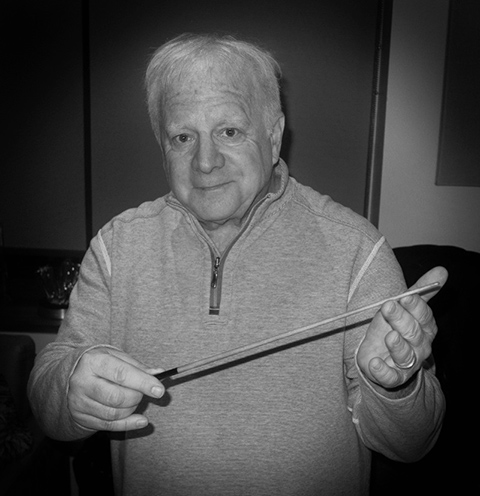
Kinah was received very well by the audience, orchestra, and critics. It is unlike anything else I have written, and it is now scheduled for performances with other orchestras over the next two seasons. The surprise was that a few conductors expressed interest in performing the work. It will be interesting to see if anyone takes up the piece and how other people interpret it.
Click here to watch KINAH on YouTube
After the performance, Cindy and I headed off to the airport for a return to Lyon. These would be the final two weeks of concerts in 2015, and certainly the first week was challenging. After Mahler 2 came the 6th, hardly a relief. In fact, the latter is certainly more difficult to put together and make cohesive. The ONL has been working its way through the cycle with me, and even though this repertoire is not always thought of as being comfortable for the French, the orchestra played it superbly.
It is truly inspiring to watch the musicians put so much effort into the rehearsal process. The 6th is a work that I have conducted often enough to have an approach that seems logical and moves the work forward. And for those of you who are Mahlerites, the Andante came second, the exposition repeat was observed, and there were only two hammer blows. Anyone confused by this reference needs only to Google the symphony to find reams of prose regarding these controversies.
For me, this is the most physically draining of the 10 works Mahler left in this form. Not that one can ever just sit back and enjoy the ride, as there really are not any moments where the conductor can ease up at all, even in the Andante. This is the first symphony where Mahler follows anything close to traditional symphonic form. There are no references to other works, either songs or tunes. In other words, this is a truly abstract piece. It is the reason I place the Andante as the second movement, even though precedent for a Scherzo being second had already been established by other composers. And the relationship of the keys is even more jarring when the Andante is performed after the first movement.
As far as the hammer goes, we finally figured out Mahler’s original conception of how the instrument was to be used.
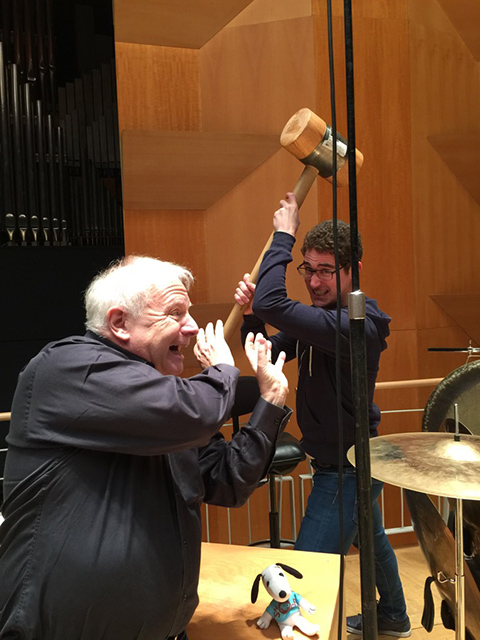
These days, the 6th is mostly performed as the sole work on the program. However, following an older tradition, we began with a Mozart concerto, in this case the A Major Violin Concerto. Our soloist was the young Norwegian Vilde Frang. Very thoughtfully creating an intimate view of the work, she still displayed the fire needed, especially in the “Turkish” section of the last movement.
The final concerts in Lyon were a bit more festive in nature. Many years ago, I put together a suite of selections from Prokofiev’s ballet Cinderella. Sadly, this music is usually eclipsed by the same composer’s Romeo and Juliet, but I find that there is just as much invention and creativity in the fairy tale. The waltzes alone are extraordinary in their melodic and harmonic adventures.
The soloist in Rachmaninov’s 2nd Piano Concerto was Nikolai Lugansky. We had not worked together in a long time, but there was an immediate rapport. Much attention was paid to various dynamic details as well as making sure that tempo transitions were smooth and not overdone. It was a pleasure to work with him, and I look forward to our next encounter.
As a side note, he decided to play a little game with me. After each performance, Nikolai played an encore, not only for the audience, but also to see if I could guess the piece. Two of them were well known to me, but the third was something I did not know. Listening backstage, I began to realize that it was a Russian composer, influenced by Rachmaninov. When Nikolai came offstage, I said that I was not sure of the piece but I believed the composer was Medtner. The pianist smiled and said that I was the first person who figured it out. But in reality, it was only a guess. Just got lucky this time.
Over the weekend, two of our good friends from St. Louis came to visit us in Lyon. Susan and Marc Gordon were in the orchestra while I was music director, and Marc was responsible for helping me create Notes from Hollywood, a chamber music event that depicts what it was like growing up in LA. For the Lyon performance, we brought over Tom Heitman, and he sang five of the tunes on the Sinatra Close to You album that was recorded with the Hollywood String Quartet. I had a chance to play piano on a couple of the pieces on the program. One of the great pleasures of these events is the opportunity for me to share stories with the musicians and audiences about the incredible quality of music-making that occurred on the West Coast in the middle of the 20th century.
Now it was time for some R&R. Cindy and I decided that we had traveled enough in 2015, so we just stayed at home for three weeks. It was critical to revisit the first six Star Wars films to be fully prepared for Chapter 7. During the second week of the vacation, Daniel and his girlfriend, Bridget, came to visit. Some of her family had Michigan ties, but this was the first time she had been in the state. Showing off some of the sights and sounds was a lot of fun.
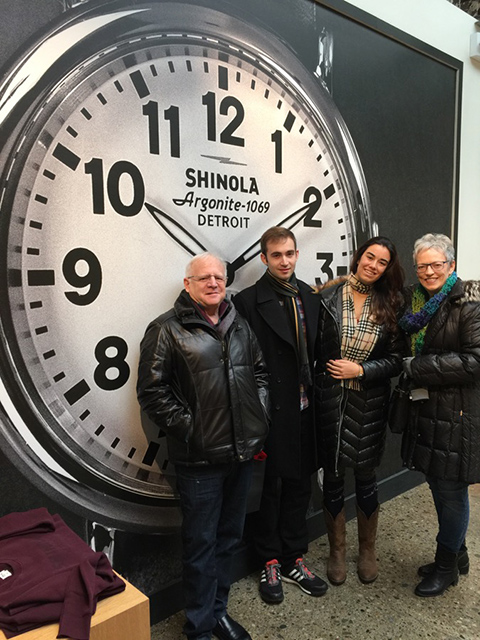
There was one event where my services were required during this respite. Last season, the DSO started doing New Year’s Eve concerts. Principal Pops Conductor Jeff Tyzik led the event, and this year, we split the duties. This gave me the opportunity to premiere some of my dad’s arrangements of classical music rewritten as pops pieces. Because the music does not physically exist, Cindy transcribed the recordings and filled them out for full orchestra. Now we have the start of what could be an interesting collection of works for future pops concerts. Perfect stuff for New Year’s, but I could not help wondering how many in the audience actually knew the classical music that was being referenced.
***
My own listening these past few weeks has been a strange comparison between Billie Holiday and Ella Fitzgerald. Those that argue that Ella was not really a jazz singer need to hear the live-performance recordings that exist, where her scat singing is as good as it gets. Yes, she ventured into the more popular fare in later years, but there is no denying that her voice was one of a kind, and she had impeccable taste. There is also no question that she understood exactly what she was singing about, and her variety of shadings show this clearly.
Lady Day is more problematic for me. Like Ella, the minute she opens her mouth, you know who it is. But what troubled me after listening to so many tunes back to back was the sameness of the vocal sound. Unique, certainly, but for me, best taken in smaller doses. As she sings, one does sense a truly troubled soul trying to make each song positive in some way. Underneath it all is a feeling of torture of some kind that is difficult for me to describe. There were moments when I truly felt uncomfortable listening to her, not because of how she sang, but on account of knowing about her life, which clearly affected how she approached each number.
***
The new year promises a lot of activity, with very little break in the action for six months. January alone sees two world premieres, a recording, a presentation of Bartok’s Bluebeard’s Castle, and so much more.
Cindy and I do want to wish each of you the very best for 2016, and I will see you next month.
Leonard
P.S.
Just after I finished this entry, I received word of the death of my good friend Gilbert Kaplan. His contributions to the world of economics became overshadowed by his passion for the 2nd Symphony of Gustav Mahler. No one did as much for this composer in terms of research and performance as Gil. His friendship with me lasted for a very long time, and it is so heartbreaking that this will no longer continue. But there is no question that every time I perform a work by Mahler, it will be Gil’s voice that guides how I think and feel about this music. A very sad start to the new year.
I posted the following message on slippedisc.com:
Gil left the musical world a much better place because of his passion, searching for the truth and his commitment to helping others. He truly embodied all the positive aspects of the misused term, “Amateur.” We all learned so much from his scholarship as well as understanding how one person can change the way we think.
Last evening, during a break in our New Year’s concert here in Detroit, I received a message from his beloved wife Lena. She wrote that the end was near. A few weeks ago, when Gil’s assistant Heidi Bryson presented me with a baton that Mahler himself had used to conduct the 2nd Symphony, it became clear that the end was near. With his family by his side, and unconscious for two days, Gil passed away a little after two in the morning.
He was one of my very closest friends. I cannot begin to express how much I will miss him. This gentle soul, with the heart of a giant, will not be forgotten. When Gil gave his lectures about Mahler, they always ended with one song, “ice bin der welt abandon gekommen.” I know what I will be listening to today.
RIP my dear friend.
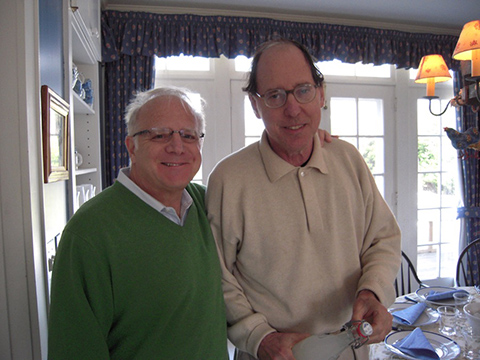
With Gil in April 2010
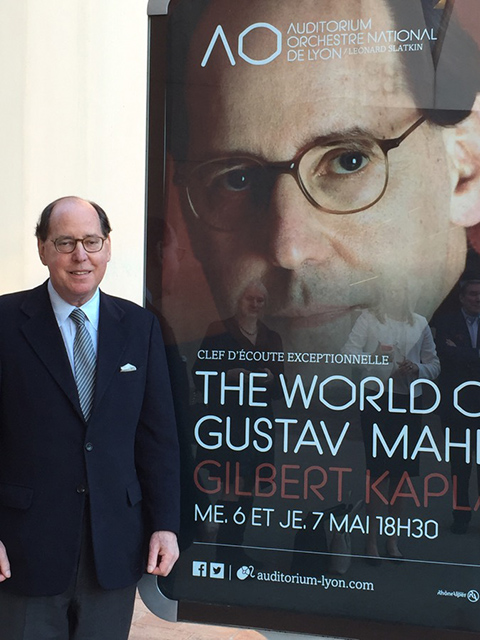
Gil in Lyon as guest lecturer with the ONL in May 2015